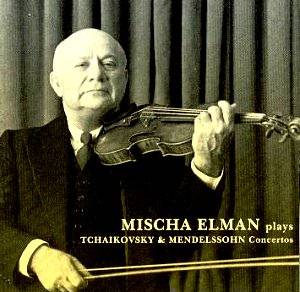Elman made two commercial recordings of the Tchaikovsky
Concerto. The first, with Barbirolli in 1929, has seldom been out of
the catalogue in one form or another. The second dates from an LPO session
with Boult in 1954 and is much less well known. But dating from December
1945 comes this live Boston/Paray traversal that catches the great violinist
still on the right side of physical infirmity and a gradual but inexorable
waning of powers. These latter do manifest themselves in particular
ways in the companion concerto, the Mendelssohn.
In terms of structure the Boston performance of the
Tchaikovsky differs little from the 1929 traversal; the timings for
the first movement are in fact almost identical though there are differences
in matters of thematic emphasis, metrical displacements, vibrato usage
and phrasal elasticity. This is still however, very recognisably, the
master tonalist of old, one who imbued every phrase with lavish intensity
and a throbbing, molten vivacity. He brings intense concentration and
expressive shading to his opening rhetorical statement and the Elmanesque
rubato that no-one could quite match. He is very slow and highly romanticised;
the orchestral pizzicati that point the rhythm are delayed an age as
a result. Elman lavishes prayerful simplicity after the cadenza and
his voluptuous vibrato takes on an ever more devastating candour. Behind
him the Boston winds are highly characterful and though there is some
crunch and other such aural damage (especially in tuttis) it will detain
only the pickiest of listener. Elman is not quite certain in his passagework
at the end of the movement – though the harmonics are negotiated well
enough – but one can hear how eventful and tactful is Tchaikovsky’s
orchestration when a fine conductor is in charge clarifying lines. The
orchestra emerge newly distinctive in the slow movement – flute and
clarinet principals especially. Elman’s phrasing rises and falls, ever
more rapturous and involved, his line taking on more and more a sense
of direction, the orchestral string blending under Paray of real distinction.
In the finale the orchestral accents are commensurately strong; this
is the one movement where the excitement of a live performance impels
Elman to a fleeter performance than his earlier commercial recording
though oddly it’s not necessarily more overpoweringly exciting.
The Tchaikovsky is a reminder of Elman’s eminence;
in the first decade of the century it was he who was the most fêted
of young fiddlers and the Tchaikovsky was for a decade or more "his"
concerto. The Mendelssohn dates from November 1953. His slightly earlier
commercial recording with Defauw and the Chicago Symphony has always
been highly regarded whilst the twilight Vanguard session in Vienna
that produced the later disc, with the State Opera Orchestra under Golschmann
has not. Again Elman’s overall conception changed little and the difference
in timings between Mitropoulos and Golschmann are negligible. Elman
is perhaps guilty of some rough playing in the opening movement of the
Concerto; some rather inelegant expressive pointing is another particular
feature (but how irrepressibly Elman it sounds). With the highlighting
comes a rather static introspection and an equally glutinous tonal projection
that can too dramatically personalise the line. Nevertheless against
this one can cite the finger position changes that remind one of the
old lion and the beautiful strands of lyrical weight he can and does
lavish – even if the vibrato itself is now slowing and the tempos ossifying
somewhat in terms of phrasal interconnectedness. In the Andante he no
longer possesses the elfin projection or sense of relaxation that the
greatest interpreters of this work bring to it (if indeed he ever really
did – his recording with Defauw, though of course highly personalised,
was highly impressive). He does rather distend the movement (to 7.50).
He is jaunty and unmotoric in the finale; he never used it as a piece
of showmanship as other, less scrupulous colleagues did. He also makes
a couple of fluffs on the lower strings but these are minor details
– even if the final bars are rather grandiosely emphatic.
The recordings have been handled with skill; the attendant
problems are really insignificant ones and won’t be in any way problematic.
As one who welcomes anything by Elman, no matter how minor, these major
live performances have a still compelling part to play in expanding
and widening the Elman discography; that they are ancillary to the main
body of his recordings is undeniable but wise heads will want to hear
them and reflect on Elman’s place in the hierarchy of great violinists.
Jonathan Woolf

